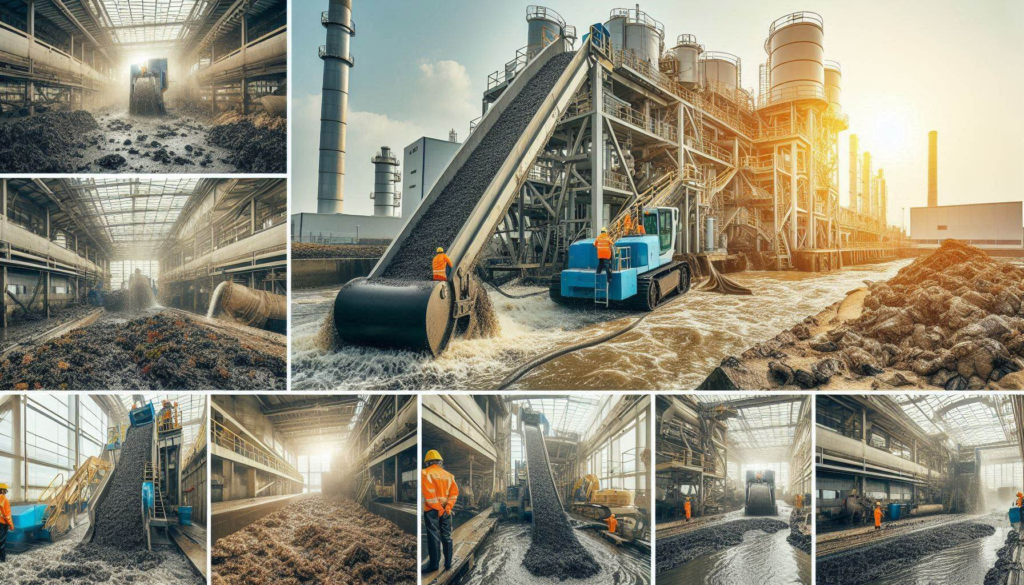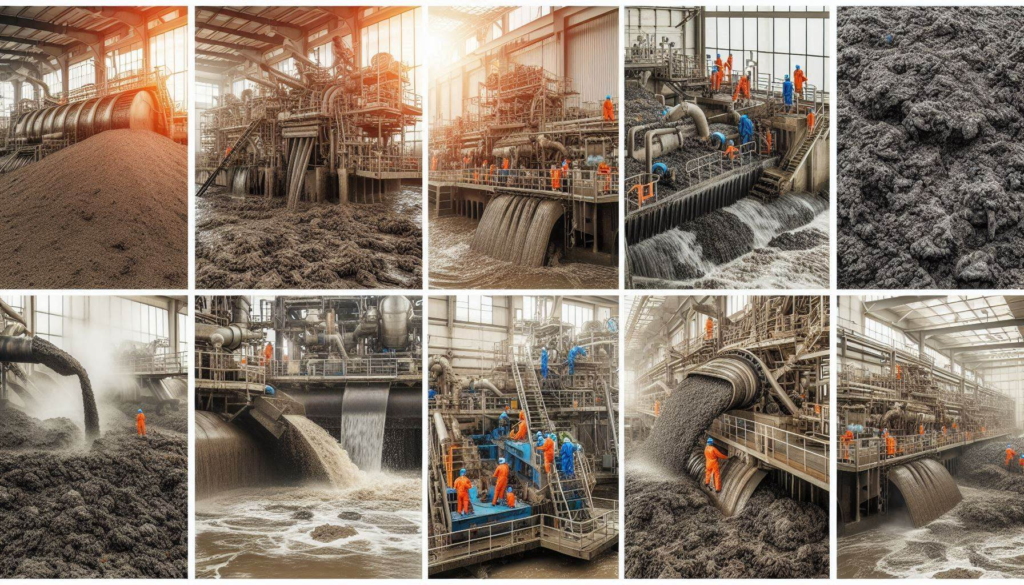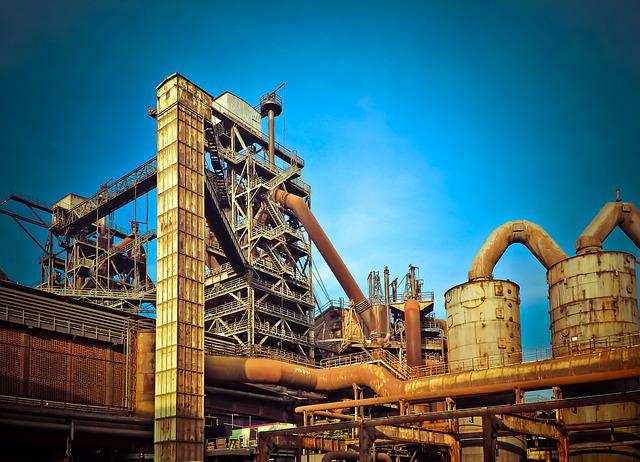What is Sludge Dewatering? – Overview of Sludge Thickening & Dewatering
Sludge watering refers to the process of reducing waste volume in preparation for its efficient disposal. The wastewater is treated before it can be released into the environment. Sludge forms during this process. Sludge, which is a by-product of wastewater treatment in industrial and municipal settings, has been a problem for water treatment companies for a long time. The sludge can be dewatered with a filter press to reduce its weight and volume before it is disposed of.
In this article, we’ll walk through what sludge dewatering is, how it works, and why it’s essential for efficient wastewater management. Along the way, we’ll also cover sludge thickening, its role in the process, and how both methods can help reduce costs and environmental impact.
Table of Contents
What is “Sludge”?
Simply put, “sludge” can be described as a semi-solid slurry produced by a variety industrial and municipal processes.
Sludge dewatering serves the purpose of efficiently and reliably concentrating wastes into high-solids filter cakes that can be disposed of easily and economically. There are strict regulations regarding the disposal of sludge. Many companies, municipalities, or institutions have sustainability goals that comply with regulations and meet their organizational and environmental requirements.
What is the Purpose of Sludge Dewatering?

Sludge dewatering is a process that separates sludge from liquids and solids in order to minimize waste. There are many options for dewatering sludge, including geomembranes, plate and frame filter presses, belt filter presses and screw pressing. There are many other options.
Important to remember that dewatering does not treat the liquid or sludge. It only separates the liquid and solid components to make it easier and cheaper to dispose of the individual phases. After the sludge is dewatered, the liquid and solid components might contain contaminants that need to be removed.
Why is Sludge Dewatering Important?
Wastewater treatment plants produce a lot of sludge every day. This sludge is mostly water, making it heavy and expensive to transport and dispose of. That’s where sludge dewatering comes in—it removes the extra water, making the sludge easier and cheaper to handle. Here’s why this process is so important:
1. Cuts Down Disposal Costs
Sludge is expensive to get rid of, especially when it’s full of water. Water adds weight, and more weight means higher transportation costs. By removing water, sludge dewatering reduces the overall weight and volume, making disposal much cheaper.
2. Makes Handling Easier
Wet sludge is messy and hard to manage. It’s sticky, heavy, and takes up a lot of space. Dewatering turns it into a drier, more solid material that’s easier to store, transport, and process further.
3. Helps the Environment
If wet sludge is dumped in a landfill, it can leak water into the ground, which may carry harmful chemicals and bacteria. This leaking water, called leachate, can pollute soil and water sources. Dewatering removes excess water before disposal, reducing the risk of pollution.
4. Allows for Resource Recovery
Dewatered sludge isn’t just waste—it can be reused. Some types of dried sludge can be used as fertilizer in agriculture, as material for making bricks and cement in construction, or even as fuel for energy production. Instead of filling up landfills, sludge can be turned into something useful.
What is the Sludge Dewatering Process?
Sludge Thickening or Dewatering both produce a concentrated, consolidated product. This retains most of the solids in the original sludge and a diluted stream that is predominantly water. Both of these processes send the dilute stream back to the wastewater treatment plant.
The thinning processes concentrate the sludge by removing a portion of the -free water. The finished product retains the liquid-free-flowing characteristics and can be transported by pumping. Normally, the dry solids content is increased by thickening to around 4-6%.
The sludge water content is removed significantly during dewatering to create a concentrated sludge product, with a DS concentration typically between 15 and 45%.
This product is known as a cake. It forms lumps that can only be transported using a conveyor belt, machine earth-moving equipment or spade.
To remove more water than that which is possible with thickening, dewatering processes use a substantial mechanical force. These processes work by:
- To force the water (or filtrate), through the sludge, press the filter (belt filter press, screw pressing or filterpress).
- To force the denser solids and water to adhere to the vessel’s internal walls, rapidly rotate the sludge inside a cylindrical vessel. The water will form the diluted centrate stream ( centrifugation).
- Passing the sludge along a narrow flow channel with porous walls, through which the filtrate flows ( Rotary press).
- Allowing the liquid to evaporate in ambient conditions (sludge drying lagoons), or both evaporate and drain under gravity using a permeable medium (sludge dry bed).
Benefits of Sludge Dewatering

Waste Volume Reduction
Sludge dewatering is a weight- and volume-reduction method that minimizes waste disposal costs. As the name suggests, water removal is the main means to reduce the volume of sludge before it can be economically disposed off.
Lower Transportation Costs
Management of sludge is a difficult business. Dry, high solids cakes mean lower costs. The use of dewatering equipment can be an effective tool to manage sludge accumulation and reduce storage costs.
Consistent dryness with lower risk of leaching
Consistent cake dryness is achieved by sludge-dewatering filter presses. Dry, high solids cakes are less expensive to transport and have a lower chance of leaking onto roads. This is especially important when trucks are passing through residential areas.
Wastewater Recycling
Recycling wastewater is another advantage of sludge-dewatering. Industries and communities can reclaim the water after it has been treated with sludge. The water is not potable but it can still be used for many purposes. Reclaimed water can be used to benefit a community or company by steam powered plants.
Equipment can be easily automated
Many people think that filter presses are labor-intensive equipment. But, in fact, sludge dewatering presses can come with automatic cloth washers, mechanically-assisted cake release, and sophisticated control systems, allowing communication to the main plant control system, all making sludge dewatering much easier.
Eco-Friendly
Sludge dewatering can be environmentally friendly because it reduces the volume of waste and makes it easier to dispose. The dry cakes can be disposed off, but the reuse of the filtrate could reduce the need for water for treatment in municipal or industrial wastewater plants and reduce overall water consumption.
Sludge Cake – What Happens After Dewatering?
After sludge is dewatered, what’s left is called sludge cake. This is a semi-solid material that usually contains 20% to 40% solids, with the rest still being water. It looks like thick, damp soil or clay. The next step depends on the type of sludge and local regulations. Some sludge cake can be reused, while other types need to be disposed of properly.
Common Uses of Sludge Cake
1. Land Application – Turning Sludge into Fertilizer
In some areas, sludge cake can be used to improve soil quality. Farmers and landscapers sometimes use treated sludge as a fertilizer or soil conditioner to help crops grow. However, before it can be applied to land, the sludge must go through extra treatment to remove harmful bacteria, metals, and other contaminants. This method is popular in agriculture because it recycles nutrients back into the soil instead of wasting them.
2. Energy Recovery – Using Sludge as Fuel
Sludge cake contains organic material, which means it can be burned for energy. Some treatment plants and factories dry sludge and use it as fuel, just like wood or coal. Another method is to use biogas production, where bacteria break down sludge in special tanks to produce methane gas. This gas can then be burned to generate electricity and heat. Using sludge for energy helps reduce waste and can be a cleaner alternative to fossil fuels.
3. Landfill Disposal – The Least Preferred Option
If sludge cake can’t be reused, it may be sent to a landfill. However, this is not the best option because it takes up valuable landfill space and can cause environmental problems. Even though dewatered sludge is less likely to leak harmful liquids into the ground, it’s still not an ideal solution. Many places are trying to find better ways to reuse sludge instead of just dumping it in landfills.
Comparing Sludge Thickening vs. Sludge Dewatering
| Parameter | Thickening | Dewatering |
|---|---|---|
| Goal | Reduce free water content | Remove bound water |
| Solids Content | 4% to 6% | 20% to 40% |
| Methods Used | Gravity thickening, DAF, etc. | Belt press, centrifuge, etc. |
| End Product | Thickened sludge | Sludge cake |
| Energy Requirement | Low | Moderate to high |
Challenges in Sludge Dewatering
Sludge dewatering sounds simple—just remove the water and reduce the weight—but in reality, it comes with several challenges. The process requires the right equipment, careful handling, and compliance with environmental rules. Here are some of the biggest challenges wastewater treatment plants face when dewatering sludge:
1. High Operating Costs
Dewatering isn’t cheap. The machines used—like centrifuges, belt presses, and filter presses—consume a lot of electricity and need regular maintenance to keep working properly. If a machine breaks down, repairs can be expensive and can slow down the entire operation. Some facilities try to cut costs by using newer, more energy-efficient equipment, but the upfront investment is still high.
2. Odor Problems
Sludge isn’t just water and dirt—it also contains organic waste and bacteria, which can create a strong, unpleasant smell if not handled properly. The odor can be especially bad in hot weather, making it difficult for workers and nearby communities. To control smells, treatment plants often use chemical additives, covered storage areas, and proper ventilation. However, these solutions add extra costs to the process.
3. Disposal Restrictions
Getting rid of sludge cake isn’t as simple as dumping it anywhere. Environmental laws regulate where and how sludge can be disposed of. Some areas ban landfill disposal due to pollution risks, while others require special treatment before sludge can be used in agriculture. Stricter rules mean treatment plants must find alternative solutions like recycling sludge for energy or composting. Keeping up with changing regulations can be time-consuming and costly.
4. Different Types of Sludge Make the Process Complicated
Not all sludge is the same. The composition of sludge depends on the type of wastewater it comes from—industrial sludge is different from household wastewater sludge. Some sludge has a high oil or chemical content, making it harder to dewater. Others contain fine particles that make it difficult for water to separate. Because sludge varies so much, treatment plants must adjust their dewatering process based on the specific type they’re dealing with. This can slow down operations and increase costs.
Cost Implications of Sludge Dewatering

Sludge dewatering, though essential, involves significant initial investment in equipment, energy consumption, and ongoing maintenance. For many wastewater treatment plants, these upfront costs can be a financial hurdle. However, when you take a closer look at the long-term financial benefits, it becomes clear that dewatering is a cost-effective solution in the bigger picture.
Upfront Costs of Sludge Dewatering
- Equipment Procurement
The primary expense in sludge dewatering is the cost of purchasing dewatering equipment. Devices like centrifuges, belt filter presses, and screw presses come with high price tags due to their complex design and technology. A centrifuge, for example, might require a significant capital investment but offers high efficiency for continuous operations. - Installation and Commissioning
Once the equipment is acquired, installation adds another layer of expense. This includes the cost of structural modifications, electrical work, and integration with existing wastewater treatment systems. Commissioning the equipment, training staff, and ensuring that the system operates optimally also add to the initial financial burden. - Energy Consumption
Most dewatering methods rely heavily on power. Centrifuges, in particular, consume large amounts of energy because they operate at high speeds. Even lower-energy options, such as screw presses, require a continuous power supply, which can significantly increase the plant’s operating costs, especially in regions with high electricity rates. - Chemical Usage
Dewatering processes often require the addition of chemicals, such as flocculants and coagulants, to enhance water separation. The cost of these chemicals can vary depending on sludge composition, treatment volume, and local supply chains. While necessary, these ongoing chemical expenses can contribute significantly to the total operating costs.
Operational and Maintenance Costs
- Labor Costs
Skilled operators are required to monitor and maintain dewatering equipment. Regular inspections, cleaning, and minor repairs are necessary to keep the system running efficiently. If a plant lacks in-house expertise, outsourcing maintenance or hiring specialized technicians may add to labor expenses. - Routine Maintenance and Spare Parts
Dewatering equipment, particularly centrifuges and belt filter presses, undergoes wear and tear due to constant operation and the abrasive nature of sludge. Routine maintenance includes replacing belts, bearings, and other moving parts. Delaying maintenance can lead to equipment breakdowns, resulting in unplanned downtime and costly repairs. - Odor and Emission Control
Depending on the type of sludge and dewatering method used, there may be additional costs associated with odor control. Some plants install odor-reduction systems or use deodorizing chemicals to maintain air quality and comply with environmental regulations.
Long-Term Savings from Dewatering
Despite the significant upfront and operational costs, sludge dewatering leads to long-term savings that can make the investment worthwhile.
- Reduced Sludge Volume
One of the most significant advantages of dewatering is the reduction in sludge volume by up to 80%. This directly impacts disposal costs, as smaller volumes require fewer trips to landfills or other disposal sites. Transport costs, which are often charged by weight or volume, decrease substantially when the water content is minimized. - Lower Disposal Costs
Dewatered sludge is denser and contains less water, meaning landfill operators charge less for its disposal. In some regions, disposal fees are based on wet weight, making dewatering critical for reducing tipping fees. Plants that previously dealt with large quantities of liquid sludge can see a drastic reduction in annual disposal expenses. - Energy Recovery Potential
Sludge with a higher solids content can be used as a feedstock for energy recovery processes, such as anaerobic digestion or incineration. Dewatered sludge burns more efficiently and generates more heat or biogas, which can be harnessed to power parts of the plant, reducing overall energy costs. In some cases, surplus energy can even be sold back to the grid, creating an additional revenue stream. - Reuse in Agriculture and Construction
Properly treated dewatered sludge can be repurposed as a soil amendment in agriculture or as a raw material in construction (e.g., as a component in bricks or cement production). Selling or donating the dewatered sludge for these applications can offset some of the treatment costs.
Cost-Benefit Analysis Over Time
A typical cost-benefit analysis of sludge dewatering would look something like this:
| Aspect | Initial Cost | Long-Term Savings |
|---|---|---|
| Equipment | High (procurement + setup) | Savings on disposal and transport |
| Energy Consumption | Moderate to High | Potential offset by energy recovery |
| Chemical Usage | Moderate | Savings through optimized dosing |
| Labor and Maintenance | Ongoing | Avoidance of major breakdowns |
| Disposal Fees | N/A | Significant reduction in volume |
| Resource Recovery | N/A | Revenue from reuse or energy sale |
Based on this analysis, many treatment plants find that while the initial expenses may seem daunting, the long-term operational savings and added benefits outweigh the upfront investment. Plants with higher sludge volumes tend to achieve faster payback periods due to greater cost reductions in transport and disposal.
Future Trends in Cost Reduction
Sludge dewatering is an expensive process, but new technologies and smarter ways of handling sludge are helping to cut costs and improve efficiency. In the coming years, wastewater treatment plants will rely on better equipment, automation, and resource recovery to make sludge dewatering more affordable and sustainable. Here are some of the key trends that are expected to bring down costs:
1. Energy-Efficient Equipment
One of the biggest costs in sludge dewatering comes from energy use. Many older machines, like centrifuges and belt presses, require a lot of electricity to run. However, newer systems are being developed with energy-saving features.
- Screw presses are becoming popular because they use less power while still being effective at removing water.
- Electro-dewatering systems apply a small electrical current to help water separate from sludge faster, reducing the time and energy needed for the process.
- More advanced filtration systems are improving water removal while using less power, lowering overall energy costs.
These improvements mean that wastewater treatment plants can spend less money on electricity while still achieving high-quality sludge dewatering.
2. Automation and AI Integration
Technology is changing the way sludge dewatering works. Automated systems equipped with sensors and artificial intelligence (AI) can help treatment plants run more efficiently. These systems can:
- Monitor and adjust chemical dosing to use the right amount of chemicals, preventing waste and saving money.
- Control energy usage by running equipment only when needed.
- Detect equipment issues early, reducing the risk of expensive breakdowns and repairs.
Although installing automation requires an initial investment, the long-term savings on energy, labor, and maintenance make it a cost-effective solution. Many treatment plants are moving toward AI-driven operations to reduce human error and improve efficiency.
3. On-Site Resource Recovery
Instead of just treating and disposing of sludge, more facilities are now looking at sludge as a resource rather than waste. New technologies are allowing treatment plants to recover valuable materials from sludge, including:
- Phosphorus recovery: Phosphorus is an important nutrient for farming, and extracting it from sludge can provide a reusable fertilizer for agriculture.
- Biogas production: Organic materials in sludge can be broken down to produce methane gas, which can then be used to generate electricity and heat. Some treatment plants are even selling excess energy back to the grid.
- Dried sludge as fuel: Some industries can burn dried sludge as a replacement for coal or other fossil fuels, reducing costs and environmental impact.
FAQs About Sludge Dewatering
Sludge dewatering removes bound water, producing a drier product with higher solids content (20% to 40%). Thickening, on the other hand, focuses on removing free water, resulting in a concentrated sludge with lower solids content (4% to 6%). Dewatering significantly reduces volume, making sludge easier to handle and dispose of.
Dewatered sludge has multiple applications, such as soil conditioning in agriculture due to its nutrient content. It’s also used as an energy source in incineration or anaerobic digestion. In construction, sludge can be added to produce materials like bricks or cement. Alternatively, it may be sent to landfills for safe disposal.
Sludge conditioning is essential for enhancing dewatering efficiency by improving the separation of water from solids. It involves adding chemicals like polymers or lime to help form larger flocs. Without proper conditioning, dewatering equipment may clog, resulting in higher moisture content, reduced performance, and increased operating costs.
Most types of sludge can be dewatered, but the ease and efficiency of the process vary depending on the sludge’s composition. Primary sludge, which is rich in organic material, is generally easier to dewater than secondary sludge, which contains more microorganisms and fine particles. Sludge from industrial wastewater treatment plants may contain chemicals or heavy metals that can affect the dewatering process and require specialized equipment or pre-treatment. Some types of sludge, such as oily sludge, can be particularly challenging to dewater because the oil can interfere with water separation. In such cases, advanced techniques like chemical conditioning or thermal treatment may be necessary to improve dewatering efficiency.
While sludge dewatering is a beneficial process, it does come with certain risks. One potential risk is the production of odors, especially if the sludge contains a high level of organic matter. Without proper odor control measures, dewatering can release foul-smelling gases, affecting plant workers and nearby communities. Another risk is equipment failure due to poor maintenance or improper operation. Dewatering equipment often handles abrasive materials, and if not properly maintained, it can suffer from wear and tear, leading to costly repairs and downtime. Additionally, improper disposal of dewatered sludge can pose environmental risks, such as soil and water contamination. It’s essential to follow regulatory guidelines for handling and disposing of sludge to mitigate these risks.
There are several ways wastewater treatment plants can enhance dewatering efficiency. Proper sludge conditioning is one of the most effective methods, as it helps improve water separation. Regular maintenance and cleaning of dewatering equipment ensure that it operates at peak performance, reducing downtime and extending its lifespan. Adjusting operating parameters, such as pressure, speed, and chemical dosing, can also have a significant impact on dewatering efficiency. Many plants are now adopting automation and real-time monitoring systems, which use sensors and software to optimize the process continuously. Additionally, using advanced technologies, such as electro-dewatering or vacuum-assisted drying, can further improve efficiency, especially for difficult-to-dewater sludge types.
















